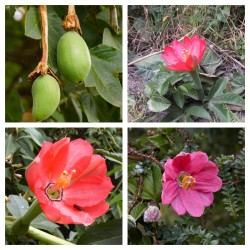Menu
-
MenuInapoi
- Home
-
Categorii
-
-
Categorii
-
Semințe de legume
-
Soiuri după țară
- Soiuri din Armenia
- Soiuri din BiH
- Soiuri din Croația
- Soiuri din Franța
- Varieties from Germany
- Varieties from Greece
- Varieties from Hungary
- Soiuri din India
- Varieties from Italy
- Soiuri din Japonia
- Soiuri din Macedonia de Nord
- Varieties from Peru
- Varieties from Russia
- Varieties from Serbia
- Soiuri din Slovenia
- Varieties from Spain
- Varieties from Thailand
- Soiuri din Turcia
- Varieties from USA
- Semințe de roșii
- Semințe de porumb
- Familia Dovleac
- Familia Bean
- Semințe de castraveți
- Seminte de ardei gras
- Familia morcovului
- Familia ceapa
- Semințe de salată verde
- Familia cartofilor
- Familia de varză
- Semințe de ridiche
- Familia sfeclei
- Semințe de pepene verde
- Semințe de pepene galben
- Semințe de conopidă
- Familia de floarea soarelui
-
Soiuri după țară
- Semințe de fructe
- Seminte de Chili Peppers
- Semințe de plante medicinale
- Semințe de plante cățărătoare
- Copaci - Arbust - Semințe
- Semințe de palmier
- Semințe de ierburi ornamentale
- Semințe de tutun
-
Semințe de legume
-
-
-
-
- PRODUSE NOI
- Crează un cont
- Livrare - Plata
- FAQ
Last Product Reviews
Out of the two seeds, one germinated and the other one was dead and floatin...
By
 Riikka H on 07/03/2024
Riikka H on 07/03/2024
Verified Purchase
Sunt 384 produse.
Se afiseaza 346-360 din 384 produs(e)
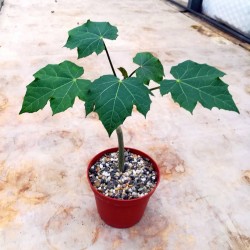
Semințe de nuci fizice...
Pret
3,75 €
(SKU: T 92)
Seeds Gallery EU,
5/
5
<h2><strong>Semințe de nuci fizice (Jatropha curcas)</strong></h2>
<h2><span style="color: #ff0a0a;"><strong>Preț pentru un pachet de 3 semințe.</strong></span></h2>
<dl style="color: #202122; font-size: 14px;">
<dd>Jatropha curcas: cunoscut sub numele de pilón de tempate, este un arbust de până la 5 metri înălțime, monoic, originar din America Centrală.<br>Este cultivat pe scară largă pentru proprietățile medicinale ale frunzelor și semințelor, care sunt: vindecătoare, dezinfectantă și purgativă. Dar fructele sau semințele nu pot fi ingerate direct, ci trebuie folosite fie ca cataplasmă, fie prin mestecarea a trei semințe cu jumătate de litru de apă pentru o perioadă de timp și apoi înghițire.<br>Jatropha integerrima: cunoscut sub numele de peregrina, este un arbust înalt de 2-3 metri cu tulpini suculente originar din America Centrală.<br>Jatropha multifida: este un arbust sau copac mic de până la 6 metri înălțime originar din sudul Americii de Nord, Mexic și Cuba.<br>La fel ca J. curcas, semințele proaspete pot fi folosite ca vindecare și purgativ, dar cu grijă.<br>Jatropha podagrica: cunoscută sub numele de pelerină regală sau spurge, este o plantă originară din America Centrală care crește până la o înălțime de 1-2 metri. Vezi fișierul.<br><br>Care sunt grijile lor?<br>Dacă doriți să aveți un specimen de jatrofă, vă recomandăm să aveți grijă de acesta după cum urmează:<br><br>Locație:<br>Afară: trebuie să fie afară, în plin soare.<br>Interior: puneți-l într-o cameră luminoasă, fără curenți de aer.<br>irigare: destul de rar. Vara de aproximativ 2 ori pe săptămână și la fiecare 10 zile restul.<br>Teren:<br>Grădină: trebuie să aibă un drenaj foarte bun, deoarece se teme de îmbătrânire.<br>Ghiveci: recomandabil să-l plantați pur și simplu în piatră ponce, pentru a-l ajuta la rădăcină.<br>Abonat: poate fi plătit adăugând un pic de gunoi de oaie de exemplu dacă este în sol sau cu guano lichid dacă este într-o oală.<br>multiplicare: prin semințe primăvara.<br>Rusticitate: nu suporta frigul sau gerul.</dd>
</dl><script src="//cdn.public.n1ed.com/G3OMDFLT/widgets.js"></script>
T 92 (5 S)

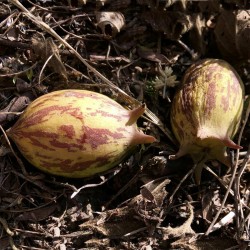
Semințe de granadină...
Pret
8,95 €
(SKU: V 105)
Seeds Gallery EU,
5/
5
<h2><strong>Semințe de granadină (Jarilla heterophylla)</strong></h2>
<h2><span style="color: #ff0a0a;"><strong>Preț pentru un pachet de 3 semințe.</strong></span></h2>
O rudă uitată a papaya obișnuită, această plantă erbacee târâtoare sau decumbentă se găsește în păduri de stejar și foioase și habitate secundare din Mexic până în America Centrală la altitudini între 1500 și 2700 m.<br><br>Crește doar până la 1 m înălțime dintr-o rădăcină carnoasă, sferică, tuberoasă, de aproximativ 15-20 cm în diametru. Tulpinile delicate se ramifică de la bază și dețin frunze ondulate sau dințate și flori albicioase, cu atingeri ocazionale de violet, urmate de fructe curioase, cu coarne, globoase, de aproximativ 2,5 cm în diametru și de la verde la purpuriu cu dungi albe.<br><br>Fructele Jarilla heterophylla se găsesc ocazional pe piețele rurale din Mexic și sunt foarte apreciate pentru gustul lor aromat, plăcut și aromat, cu note de citrice și muștar.<br><br>Acestea sunt de obicei transformate în conserve și sosuri care însoțesc diferite carne.<br><br>Etichete: brassicales, caric, perene de foioase, fructe comestibile, granadina, heterophylla, jarilla, jarill, nana<script src="//cdn.public.n1ed.com/G3OMDFLT/widgets.js"></script>
V 105 (3 S)


Planta rezistenta la frig si inghet
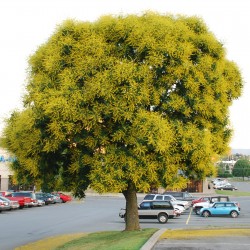
Semințe de Oțetar galben...
Pret
1,65 €
(SKU: T 93)
Seeds Gallery EU,
5/
5
<h2><strong>Semințe de Oțetar galben (Koelreuteria paniculata)</strong></h2>
<h2><span style="color: #ff0000;"><strong>Preț pentru un pachet de 10 semințe.</strong></span></h2>
Koelreuteria paniculata este o specie de plantă cu flori din familia Sapindaceae, originară din Asia de Est, în China și Coreea. A fost introdus în Europa în 1747 și în America în 1763 și a devenit un arbore peisagistic popular la nivel mondial. Denumirile obișnuite includ arborele de aur, mândria Indiei, arborele din China și arborele de lac.<br><br>Este un copac de foioase de dimensiuni mici până la mijlocii, care crește până la 7 m (23 ft) înălțime, cu o coroană largă, în formă de cupolă. Frunzele sunt pinnate, de 15–40 cm (6–16 in) lungime, rar până la 50 cm (20 in), cu 7-15 foliole de 3–8 cm lungime, cu marginea profund zimțată; foliolele mai mari de la punctul mediu al frunzei sunt uneori ele însele pinnate, dar frunzele nu sunt în mod consecvent complet bipinnate ca în Koelreuteria bipinnata înrudită.<br><br>Florile sunt galbene, cu patru petale, crescând în panicule terminale mari de 20-40 cm (8-16 in) lungime. Fructul este o păstăi vezicală umflată din trei părți, lungă de 3–6 cm și lată de 2–4 cm, adică de culoare verde, apoi coapte de la portocaliu la roz toamna. Conține mai multe semințe de maro închis până la negru cu diametrul de 5-8 mm.<br><br>Este cultivat popular ca arbore ornamental în regiunile temperate din întreaga lume, datorită atracției estetice a florilor, frunzelor și păstăilor de semințe. Au fost selectate mai multe soiuri pentru plantarea în grădină, inclusiv „Fastigiata” cu coroană îngustă și „Aur de septembrie”, care înflorește la sfârșitul verii.<br><br>În Marea Britanie, soiul „Coral Sun” a câștigat Premiul Meritului Grădinii al Royal Horticultural Society.<script src="//cdn.public.n1ed.com/G3OMDFLT/widgets.js"></script>
T 93 (10 S)


Varietate din Grecia

Planta rezistenta la frig si inghet
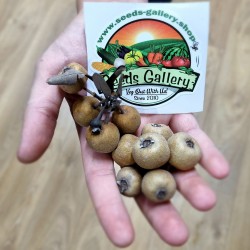
Semințe de Pară sălbatică,...
Pret
2,15 €
(SKU: V 114)
Seeds Gallery EU,
5/
5
<h2><strong>Semințe de Pară sălbatică, Pere cu frunze de migdale (Pyrus amygdaliformis)</strong></h2>
<h2><span style="color: #fe0000;"><strong>Pret pentru pachet cu 5 seminte.</strong></span></h2>
Para sălbatic, para cu frunze de migdal (Pyrus amygdaliformis) Este un arbust de foioase sau arbore inferior din familia trandafirilor (Rosaceae). Crește până la 6 m înălțime, baldachinul este neregulat, rotund, dens. Sistemul rădăcină este puternic, profund și bine ramificat. Ramurile sunt acoperite cu spini, scoarța este roșiatică, longitudinală și crăpată transversal, cu grosimea de aproximativ 1 cm. Lăstarii tineri sunt maronii, inițial dens păroși, mai târziu goi.<br><br>Mugurii sunt mici, de doar aproximativ 2 mm lungime, acoperiți cu solzi de culoare gri închis până la maro închis, care sunt fin părosi și ascuțiți. Frunzele sunt alterne, alungite eliptice, 3-8 cm lungime, 1-3 cm latime, acuminate, cu muchii intregi sau fin zimtate, verde inchis pe fata, spatele este cenusiu, fin paros, situat pe petiole subtiri de aproximativ 1- 3 cm lungime.<br><br>Florile sunt bisexuale, unisexuate, de aproximativ 2 cm, grupate 5-12 în inflorescențe grupate, corola este construită din 5 petale albe. Înflorește în aprilie și mai.<br><br>Fructele sunt rotunde, tari, inițial verzi, mai târziu galben-maronii, cu dimensiuni de 2-3 cm, situate pe tulpini scurte. Se coc în octombrie, semințele lor sunt negre, plate, de aproximativ 5-6 mm lungime.<br><br>Este răspândită în sudul și sud-estul Europei și în Asia Mică. Îl avem de-a lungul Mării Adriatice, în Istria, coastă și Dalmația. Crește în locuri calde, însorite și semi-umbrite, în desișuri, în poienițe de foioase, în pajiști, în maquis.<br><br>Rezistent la secetă, mai slab până la temperaturi scăzute, leagă bine solul și îl protejează de eroziune. Are o creștere lentă, are lăstari buni din cioturi. Este folosit uneori ca substrat pentru altoirea pomilor fructiferi.<br><br>Fructele sunt comestibile, au gust dulce-acrișor. Pot fi uscate și folosite ca ceai sau procesate după dorință.<br><br><script src="//cdn.public.n1ed.com/G3OMDFLT/widgets.js"></script>
V 114 (5 S)


Varietate din Rusia

Planta rezistenta la frig si inghet
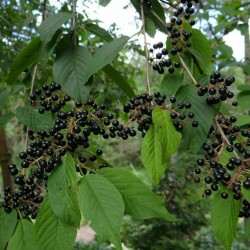
Semințe de cireș Manciurian...
Pret
1,85 €
(SKU: V 193)
Seeds Gallery EU,
5/
5
<h2><strong>Semințe de cireș Manciurian (Prunus maackii)</strong></h2>
<h2><span style="color: #fe0000;"><strong>Pret pentru pachet cu 5 seminte.</strong></span></h2>
Prunus maackii, denumit în mod obișnuit cireșul Manchurian sau Amok chokecherry, este o specie de cireșe originară din Coreea și de pe ambele maluri ale râului Amur, în Manciuria în nord-estul Chinei, și regiunea Amur și Primorye în sud-estul Rusiei. Odinioară era considerată o specie de Prunus subg. Padus, dar atât studiile morfologice, cât și cele moleculare indică că aparține lui Prunus subg. Cerasus.<br><br>Este cultivat ca arbore ornamental în nordul Europei și în America de Nord, în principal pentru coaja sa decorativă. Preferă soarele și solul umed (dar drenat) și este tolerant la frigul sever al iernii, dar nu la căldură. Fructul a fost folosit la fabricarea sucului, jeleului și gemului. Exemplarele aflate în cultură au fost măsurate la 17 m înălțime și 90 cm diametrul trunchiului.<br><br>Este un copac de foioase care crește până la 4-10 m înălțime. Scoarța copacilor tineri este foarte distinctă, netedă, de culoare galben-broniu lucioasă, dar devine fisurată și de culoare gri-brun închis odată cu vârsta. Frunzele sunt alterne, ovate, de 4–8 cm lungime și 2,8–5 cm lățime, cu un pețiol pubescent de 1–1,5 cm și o margine întreagă sau foarte fin zimțată; sunt de culoare verde închis deasupra, puțin mai palide și pubescente pe venele de dedesubt. Florile sunt produse pe vârfuri erecte de 5–7 cm lungime, fiecare floare cu diametrul de 8–10 mm, cu cinci petale albe. Fructul este o drupă mică, asemănătoare cireșului, cu diametrul de 5–7 mm, verde la început, devenind mai întâi roșie, apoi violet închis sau negru la maturitate. Înflorirea are loc la mijlocul primăverii, cu fructele coapte la începutul verii până la începutul toamnei.<script src="//cdn.public.n1ed.com/G3OMDFLT/widgets.js"></script>
V 193 (5 S)


Planta rezistenta la frig si inghet

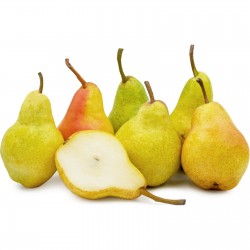
Semințe de pere Williams
Pret
1,45 €
(SKU: V 121)
Seeds Gallery EU,
5/
5
<h2><strong>Semințe de pere Williams</strong></h2>
<h2><span style="color: #fe0000;"><strong>Pret pentru pachet cu 5 seminte.</strong></span></h2>
Pera Williams este una dintre cele mai faimoase și de cea mai bună calitate soiuri de pere. Este un soi mai vechi, originar din Marea Britanie. William se maturizează în a doua jumătate a lunii august. Fructele sunt foarte mari, până la 230 g.<br><br>Arborele are până la 9 metri înălțime, florile sunt albe în floarea lui William și înflorește în aprilie și mai. Culoarea de bază a fructului este verde deschis - care la copt se transformă în galben lămâie (au fost dezvoltate soiuri de culoare roșiatică). Pe epidermă pot fi observate mici pete maro (lenticele).<br><br>Pulpa este cu granulație fină și textură foarte fină, de culoare alb-gălbui, dulce și suculentă. Este plin de aromă, cu o aromă și un miros de mosc deosebit de recunoscut, destul de pronunțat. Practic se poate spune că oamenii echivalează gustul unei pere cu gustul lui William.<br><br>Fructele au o formă caracteristică de „pere” care seamănă cu un clopot. Soiul este al lui William, dar există într-adevăr multe soiuri produse din el.<br><br>Este foarte potrivit, atât pentru utilizare proaspătă, cât și pentru prelucrare. Începe să dea roade devreme și dă naștere din belșug. Se recoltează cu 2 săptămâni înainte de coacere (de obicei la sfârșitul lunii august și în cursul lunii septembrie) și se poate păstra la frigider până la 5 luni.<script src="//cdn.public.n1ed.com/G3OMDFLT/widgets.js"></script>
V 121 (5 S)


Semințe de Palma sticlei...
Pret
4,95 €
(SKU: PS 13)
Seeds Gallery EU,
5/
5
<h2><strong>Semințe de Palma sticlei (Hyophorbe lagenicaulis)</strong></h2>
<h2><span style="color: #ff0101;"><strong>Pret pentru pachet cu 3 seminte.</strong></span></h2>
<p>Există palmieri cu adevărat impresionanți, capabili să ne lase cu gura căscată pentru frumusețea lor. Unul dintre ele este Hyophorbe lagenicaulis. Este perfect să o ai în grădini mici, iar într-o oală poate trăi mulți ani. Este cunoscut sub numele popular de Palma sticlei, deoarece portbagajul său amintește foarte mult de sticle.<br><br>Dar Care sunt grijile lor? Poți rezista frigului? Dacă doriți să știți totul despre acest palmier splendid, atunci vă vom dezvălui toate secretele, astfel încât să știți cum să îl mențineți sănătos.<br><br>Protagonistul nostru este o palmă unicaule (adică cu un singur trunchi) și veșnic verde al cărui nume științific este Hyophorbe lagenicaulis. Este o specie endemică a insulei Round, o insulă care aparține Republicii Mauritius, lângă Madagascar.<br><br>Se caracterizează prin faptul că are un trunchi destul de umflat, gros de aproximativ 40-50cm în partea sa cea mai lată. Are patru până la șase frunze pinate de culoare verde închis și atinge o înălțime de aproximativ 4-5 metri. Este, după cum vedem, perfect pentru a avea în toate tipurile de grădini, fie ele mici, medii sau mari. Rata sa de creștere este medie-lentă, putând accelera puțin oferind îngrășăminte specifice pentru palmieri sau guano.<br><br>Această specie prezintă un risc ridicat de a fi în pericol de dispariție, din cauza pierderii habitatului. Chiar dacă ca plantă ornamentală pentru grădini are o supraviețuire mai mult decât asigurată, din moment ce Se reproduce ușor prin semințe și este foarte apreciat de colecționarii de palmieri.<br><br>Care sunt îngrijirile de care aveți nevoie?<br>Dacă îndrăznești să ai o copie, îți recomandăm să ai grijă de ea după cum urmează:<br><br>Locație<br><br>Palma sticlei este o plantă care îi plac expunerile luminoase, dar nu are soare direct. Acest lucru înseamnă că are nevoie de multă lumină naturală, dar dacă este expus direct razelor regelui stea, frunzele sale vor arde.<br><br>Doar dacă este un climat tropical umed, se poate obișnui cu lumina directă.<br><br>irigare<br><br>Trebuie udat de 2-3 ori pe săptămână vara, iar restul anului 1-2 la fiecare șapte sau 10 zile. Dacă îl aveți în interior, lăsați solul să se usuce înainte de a uda din nou.<br><br>Este important să udați la apus, deoarece acest lucru vă va asigura că palma sticlei poate profita de apă mai mult și mai mult timp. Folosiți apă de ploaie sau fără var dacă este posibil; În caz contrar, diluați lichidul de jumătate de lămâie într-un litru de apă, sau una sau două linguri de oțet în 5 litri / apă. Verificați cu benzi de pH dacă nu scade prea mult, deoarece dacă scade sub 4, palmierul sticlei ar suferi daune (pete pe frunze din cauza lipsei de calciu).<br><br>Teren<br><br>Ghiveci de flori: se umple cu un amestec de 60% substrat de cultură universal mixt + 30% din perlit + 10% lut vulcanic, în acest fel drenajul va fi perfect. Ghiveciul poate fi din plastic sau lut, dar este esențial să aibă găuri în bază prin care apa să poată scăpa în timpul irigării.<br>grădină: crește în soluri bogate în materie organică, ușoare și cu un drenaj bun. Este de preferat ca pH-ul să fie ușor acid, dar nici nu este obligatoriu. Dacă vedeți că frunzele devin gălbui, adăugați fier lichid (de vânzare aici) la apă și irigați.<br>Abonat<br><br>De la începutul primăverii până la sfârșitul verii Este recomandabil să îl fertilizați cu un îngrășământ specific pentru palmieri, cu guano sau alternând ambele (o lună una și luna următoare cealaltă).<br><br>Alte îngrășăminte naturale pe care le puteți utiliza, în afară de guano, sunt mulci, compost sau gunoi de grajd de la animale erbivore, dar vă recomandăm să le folosiți numai dacă planta este pe uscat, deoarece altfel substratul ar pierde capacitatea de a se scurge bine. Și repede apa.<br><br>Tunderea<br><br>Nu ai nevoie de ea. Doar frunzele uscate trebuie tăiate, odată ce sunt complet maronii.<br><br>Timp de plantare sau transplant<br><br>En primăvară. Dacă este în ghiveci, transplantați la fiecare doi ani, când vedeți rădăcini ieșind din găurile de drenaj sau dacă au trecut mai mult de trei ani de la ultima schimbare.<br><br>Plagi și boli<br><br>Este destul de rezistent în general, dar poate fi atacat de cocoșe, și într-o măsură mai mică (probabil pentru că nu este încă foarte frecventă în Spania) de către Gărgărița roșie y paysandisia, care sunt doi dintre principalii și cei mai periculoși dăunători exotici pe care palmierii îi pot avea în țara respectivă.<br><br>Dacă este supraapat și / sau dacă solul sau substratul nu este capabil să scurge bine și rapid apa, ciuperci precum phytophthora Vor începe să-și facă treaba, putrezind rădăcinile mai întâi și ucigând restul plantei mai târziu.<br><br>În funcție de problemă, trebuie tratată într-un fel sau altul:<br><br>Mealybugs: tratați cu un insecticid anti-cocoș sau cu pământ de diatomee. De asemenea, puteți curăța frunzele cu apă și săpun ușor.<br>Gărgărița și paysandisia: insecticide alternative al căror material activ este Clorpirifos cu nematode. Este interesant să optați pentru remedii netoxice, cum ar fi capcanele cu feromoni (numai dacă grădina are aproximativ 400 de metri pătrați sau mai mult), sau cu bacterii benefice pentru palmier. <br><br>multiplicare<br><br>Palma sticlei se înmulțește prin semințe primăvara sau vara, pe care este indicat să îl semănați mai întâi într-o pungă de plastic transparentă cu vermiculită umezită anterior și plasată lângă o sursă de căldură. De îndată ce rădăcina iese și frunza începe să încolțească, lucru care se întâmplă după aproximativ trei luni, este plantată în ghivece individuale cu substrat universal de creștere amestecat cu 30% perlit și lăsată în semi-umbră.<br><br>Rusticitatea palmierului sticla<br><br>Dacă trebuie să spunem ceva care nu ne place prea mult, este că, fiind originar dintr-o regiune tropicală, este foarte sensibil la frig, mai mult decât sora lui Hyophorbe verschaffeltti. Cu toate acestea, trebuie să știți că într-o cameră foarte luminoasă trăiește destul de bine, atâta timp cât este ținut departe de curenți.</p><script src="//cdn.public.n1ed.com/G3OMDFLT/widgets.js"></script>
PS 13 (3 S)


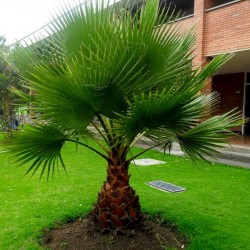
California Fan Palm Seeds...
Pret
1,95 €
(SKU: PS 1)
Seeds Gallery EU,
5/
5
<h2 class=""><strong>Washingtonia Seeds California Fan Palm</strong></h2>
<h2><span style="color: #ff0000;"><strong>Price for Package of 3 seeds.</strong></span></h2>
<p>Washingtonia Filifera is a palm native to the southern and southwestern USA states and northwest Mexico. This palm grows up to 23 m (exceptionally 30 m) in good growing conditions. The leaves have a petiole up to 2 m long, bearing a fan of leaflets 1.5-2 m long, with white, thread-like fibers between the segments. When the leaves die they bend downwards and form a skirt around the trunk. Washingtonia filifera can live from 80 to 250 years or more and is <strong>reported to be cold hardy to -12C.</strong></p>
<table cellspacing="0" cellpadding="0" border="1">
<tbody>
<tr>
<td colspan="2" width="100%" valign="top">
<p><span style="color: #008000;"><strong>Sowing Instructions</strong></span></p>
</td>
</tr>
<tr>
<td valign="top" nowrap="nowrap">
<p><span style="color: #008000;"><strong>Propagation:</strong></span></p>
</td>
<td valign="top">
<p><span style="color: #008000;">Seeds</span></p>
</td>
</tr>
<tr>
<td valign="top" nowrap="nowrap">
<p><span style="color: #008000;"><strong>Pretreat:</strong></span></p>
</td>
<td valign="top">
<p><span style="color: #008000;">soak in water for 3-4 hours</span></p>
</td>
</tr>
<tr>
<td valign="top" nowrap="nowrap">
<p><span style="color: #008000;"><strong>Stratification:</strong></span></p>
</td>
<td valign="top">
<p><span style="color: #008000;">0</span></p>
</td>
</tr>
<tr>
<td valign="top" nowrap="nowrap">
<p><span style="color: #008000;"><strong>Sowing Time:</strong></span></p>
</td>
<td valign="top">
<p><span style="color: #008000;">all year round</span></p>
</td>
</tr>
<tr>
<td valign="top" nowrap="nowrap">
<p><span style="color: #008000;"><strong>Sowing Depth:</strong></span></p>
</td>
<td valign="top">
<p><span style="color: #008000;">1 cm</span></p>
</td>
</tr>
<tr>
<td valign="top" nowrap="nowrap">
<p><span style="color: #008000;"><strong>Sowing Mix:</strong></span></p>
</td>
<td valign="top">
<p><span style="color: #008000;">Coir or sowing mix + sand or perlite</span></p>
</td>
</tr>
<tr>
<td valign="top" nowrap="nowrap">
<p><span style="color: #008000;"><strong>Germination temperature:</strong></span></p>
</td>
<td valign="top">
<p><span style="color: #008000;">min. 20 ° C</span></p>
</td>
</tr>
<tr>
<td valign="top" nowrap="nowrap">
<p><span style="color: #008000;"><strong>Location:</strong></span></p>
</td>
<td valign="top">
<p><span style="color: #008000;">bright + keep constantly moist not wet</span></p>
</td>
</tr>
<tr>
<td valign="top" nowrap="nowrap">
<p><span style="color: #008000;"><strong>Germination Time:</strong></span></p>
</td>
<td valign="top">
<p><span style="color: #008000;">until it germinates </span></p>
</td>
</tr>
<tr>
<td valign="top" nowrap="nowrap">
<p><span style="color: #008000;"><strong>Watering:</strong></span></p>
</td>
<td valign="top">
<p><span style="color: #008000;">Water regularly during the growing season</span></p>
</td>
</tr>
<tr>
<td valign="top" nowrap="nowrap">
<p><span style="color: #008000;"><strong> </strong></span></p>
</td>
<td valign="top">
<p><br /><span style="color: #008000;"><em>Copyright © 2012 Seeds Gallery - Saatgut Galerie - Galerija semena. </em><em>All Rights Reserved.</em><em></em></span></p>
<div><span style="color: #008000;"><em> </em></span></div>
</td>
</tr>
</tbody>
</table>
<script src="//cdn.public.n1ed.com/G3OMDFLT/widgets.js"></script>
PS 1 (3 S)


Planta rezistenta la frig si inghet

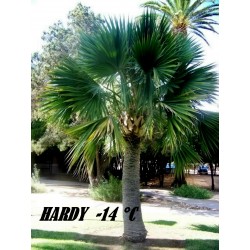
Bermuda Palmetto,...
Pret
2,00 €
(SKU: PS 4)
Seeds Gallery EU,
5/
5
<div id="idTab1" class="rte">
<h2 id="short_description_content" class="rte align_justify"><span style="font-size: 14pt;" class=""><strong>Bermuda Palmetto, Bibby-tree Seeds frost-tolerant -14 °C</strong></span></h2>
<h2 class="rte align_justify"><span style="font-size: 14pt;"><strong></strong><span style="color: #ff0000;"><strong>Price for Package of 3 seeds.</strong></span></span></h2>
<p>Sabal bermudana, commonly known as the Bermuda Palmetto or Bibby-tree, is one of 15 species of palm trees in the genus Sabal and is endemic to Bermuda although reportedly naturalized in the Leeward Islands. It was greatly affected by the introduction of non-native plants such as the Chinese Fan-Palm, which created competition for space that it usually lost.</p>
<p><strong>Description</strong></p>
<p>Sabal bermudana grows up to 25 m (82 ft) in height, with the occasional old tree growing up to 30 m (98 ft) in height, with a trunk up to 55 cm (22 in) in diameter. It is a fan palm (Arecaceae tribe Corypheae), with the leaves with a bare petiole terminating in a rounded fan of numerous leaflets. Each leaf is 1.5–2 m (4.9–6.6 ft) long, with 45-60 leaflets up to 75 cm (30 in) long. The flowers are yellowish-white, 5 mm (0.20 in) across, produced in large panicles up to 2.5 m (8.2 ft) long, extending out beyond the leaves. The fruit is a deep brown to black drupe about 1 cm (0.39 in) long containing a single seed. It is extremely salt-tolerant and is often seen growing near the Atlantic Ocean coast in Bermuda, and also frost-tolerant, surviving short periods of temperatures as low as -14 °C, although it will never get that cold in Bermuda.</p>
<p><strong>Uses</strong></p>
<p>Bermudians used to use, for a short period, the leaflets of the palm to weave into hats and export them to the United Kingdom and other countries. Sabal bermudana also had hole drilled into its trunk and sap extracted to make "bibby", a strong alcoholic beverage.</p>
<p>During the 17th century, most houses in Bermuda had palmetto-thatched roofs.</p>
</div>
<script src="//cdn.public.n1ed.com/G3OMDFLT/widgets.js"></script>
PS 4 (3 S)


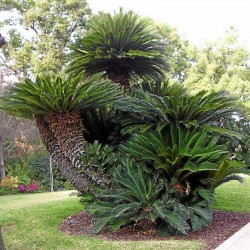
Seeds Sago Palm, King Sago,...
Pret
3,75 €
(SKU: PS 7)
Seeds Gallery EU,
5/
5
<h2><span style="font-size: 14pt;"><strong>Seeds Sago Palm, King Sago, Sago Cycad, Japanese Sago Palm</strong></span></h2>
<h2><span style="color: #ff0000; font-size: 14pt;"><strong>Price for Package of 3 seeds.</strong></span></h2>
<p>Cycas revoluta (Sotetsu [Japanese ソテツ], sago palm, king sago, sago cycad, Japanese sago palm), is a species of gymnosperm in the family Cycadaceae, native to southern Japan including the Ryukyu Islands. It is one of several species used for the production of sago, as well as an ornamental plant.</p>
<p><strong>Names</strong></p>
<p>Cycads are not closely related to the true palms (Arecaceae). The Latin specific epithet revoluta means "curled back",[2] in reference to the leaves. This is also called Kungi (comb) Palm in Urdu speaking areas.</p>
<p><strong>Description</strong></p>
<p>This very symmetrical plant supports a crown of shiny, dark green leaves on a thick shaggy trunk that is typically about 20 cm (7.9 in) in diameter, sometimes wider. The trunk is very low to subterranean in young plants, but lengthens above ground with age. It can grow into very old specimens with 6–7 m (over 20 feet) of trunk; however, the plant is very slow-growing and requires about 50–100 years to achieve this height. Trunks can branch multiple times, thus producing multiple heads of leaves.</p>
<p>The leaves are a deep semiglossy green and about 50–150 cm (20–59 in) long when the plants are of a reproductive age. They grow out into a feather-like rosette to 1 m (3.3 ft) in diameter. The crowded, stiff, narrow leaflets are 8–18 cm (3.1–7.1 in) long and have strongly recurved or revolute edges. The basal leaflets become more like spines. The petiole or stems of the sago cycad are 6–10 cm (2.4–3.9 in) long and have small protective barbs.</p>
<p>Roots are called coralloid with an Anabaena symbiosis allowing nitrogen fixation. Tannins-rich cells are found on either side of the algal layer to resist the algal invasion.</p>
<p>As with other cycads, it is dioecious, with the males bearing pollen cones (strobilus) and the females bearing groups of megasporophylls. Pollination can be done naturally by insects or artificially.</p>
<p><strong>Cultivation and use</strong></p>
<p>Propagation of Cycas revoluta is either by seed or by removal of basal offsets. It is one of the most widely cultivated cycads, grown outdoors in warm temperate and subtropical regions, or under glass in colder areas. It grows best in sandy, well-drained soil, preferably with some organic matter. It needs good drainage or it will rot. It is fairly drought-tolerant and grows well in full sun or outdoor shade, but needs bright light when grown indoors. The leaves can bleach somewhat if moved from indoors to full sun outdoors.</p>
<p>Of all the cycads, C. revoluta is the most popular in cultivation. It is seen in almost all botanical gardens, in both temperate and tropical locations. In many areas of the world, it is heavily promoted commercially as a landscape plant. It is also quite popular as a bonsai plant. First described in the late 18th century, it is tolerant of mild to somewhat cold temperatures, provided the ground is dry. Frost damage can occur at temperatures below −10 °C (14 °F), and several healthy plants have been grown with little protection as far north as St. Louis Missouri and New York, New York, both in USDA zone 7b. C. revoluta usually defoliates in this temperate climate, but will usually flush (or grow) several new leaves by spring.</p>
<p>This plant has gained the Royal Horticultural Society's Award of Garden Merit.</p>
<p>The pith contains edible starch, and is used for making sago. Before use, the starch must be carefully washed to leach out toxins contained in the pith. Extracting edible starch from the sago cycad requires special care due to the poisonous nature of cycads. Cycad sago is used for many of the same purposes as palm sago. Sago is extracted from the sago cycad by cutting the pith from the stem, root and seeds of the cycads, grinding the pith to a coarse flour and then washing it carefully and repeatedly to leach out the natural toxins. The starchy residue is then dried and cooked, producing a starch similar to palm sago/sabudana. The cycad seed contains cycasin toxin and should not be eaten as it is possible for cycasin toxin to survive the most vigorous of repeated washings. Cycasin toxin can cause ALS, Parkinson's, prostate cancer and fibrolemellar hepatocellular carcinoma.</p>
<p>Aulacaspis yasumatsui is a scale insect feeding on C. revoluta, and unchecked is able to destroy the plant.</p>
<p><strong>Chemistry</strong></p>
<p>The hydro-alcoholic extract of leaves of C. revoluta shows the presence of alkaloids, steroids and tannins while the chloroform extract shows the presence of saponins, tannins and sugars.[8] Leaflets also contain biflavonoids.[9] Estragole is the primary volatile compound emitted from the male and female cones of C. revoluta.</p>
<p><strong>Toxicity</strong></p>
<p>Cycad sago is extremely poisonous to animals (including humans) if ingested. Pets are at particular risk, since they seem to find the plant very palatable.[11] Clinical symptoms of ingestion will develop within 12 hours, and may include vomiting, diarrhea, weakness, seizures, and liver failure or hepatotoxicity characterized by icterus, cirrhosis, and ascites. The pet may appear bruised, have nose bleeds (epistaxis), melena (blood in the stool), hematochezia (bloody straining), and hemarthrosis (blood in the joints).[12] The ASPCA Animal Poison Control Center estimates a fatality rate of 50 to 75% when ingestion of the sago palm is involved. If any quantity of the plant is ingested, a poison control center or doctor should be contacted immediately. Effects of ingestion can include permanent internal damage and death.</p>
<p>All parts of the plant are toxic; however, the seeds contain the highest level of the toxin cycasin. Cycasin causes gastrointestinal irritation, and in high enough doses, leads to liver failure.[13] Other toxins include Beta-methylamino L-alanine, a neurotoxic amino acid, and an unidentified toxin which has been observed to cause hindlimb paralysis in cattle.</p>
<script src="//cdn.public.n1ed.com/G3OMDFLT/widgets.js"></script>
PS 7 (3 S)

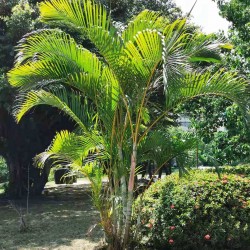
Golden cane palm seeds...
Pret
3,95 €
(SKU: PS 14)
Seeds Gallery EU,
5/
5
<h2><strong>Golden cane palm seeds (Dypsis lutescens)</strong></h2>
<h2><span style="color: #ff0000;"><strong>Price for Package of 3 seeds.</strong></span></h2>
<p><i style="color: #202122; font-size: 14px;"><b>Dypsis lutescens</b></i><span style="color: #202122; font-size: 14px;">, also known as<span> </span></span><b style="color: #202122; font-size: 14px;">golden cane palm</b><span style="color: #202122; font-size: 14px;">,<span> </span></span><b style="color: #202122; font-size: 14px;">areca<span> </span>palm</b><span style="color: #202122; font-size: 14px;">,</span><span style="color: #202122; font-size: 14px;"><span> </span></span><b style="color: #202122; font-size: 14px;">yellow palm</b><span style="color: #202122; font-size: 14px;">,</span><span style="color: #202122; font-size: 14px;"><span> </span>or<span> </span></span><b style="color: #202122; font-size: 14px;">butterfly palm</b><span style="color: #202122; font-size: 14px;">,</span><span style="color: #202122; font-size: 14px;"><span> </span>is a<span> </span></span>species<span style="color: #202122; font-size: 14px;"><span> </span>of<span> </span></span>flowering plant<span style="color: #202122; font-size: 14px;"><span> </span>in the<span> </span></span>family<span style="color: #202122; font-size: 14px;"><span> </span></span>Arecaceae<span style="color: #202122; font-size: 14px;">,<span> </span></span>native<span style="color: #202122; font-size: 14px;"><span> </span>to<span> </span></span>Madagascar<span style="color: #202122; font-size: 14px;"><span> </span>and naturalized in the<span> </span></span>Andaman Islands<span style="color: #202122; font-size: 14px;">,<span> </span></span>Réunion<span style="color: #202122; font-size: 14px;">,<span> </span></span>El Salvador<span style="color: #202122; font-size: 14px;">,<span> </span></span>Cuba<span style="color: #202122; font-size: 14px;">,<span> </span></span>Puerto Rico<span style="color: #202122; font-size: 14px;">, the<span> </span></span>Canary Islands<span style="color: #202122; font-size: 14px;">, southern<span> </span></span>Florida<span style="color: #202122; font-size: 14px;">,<span> </span></span>Haiti<span style="color: #202122; font-size: 14px;">, the<span> </span></span>Dominican Republic<span style="color: #202122; font-size: 14px;">,<span> </span></span>Jamaica<span style="color: #202122; font-size: 14px;">, the<span> </span></span>Leeward Islands<span style="color: #202122; font-size: 14px;"><span> </span>and the<span> </span></span>Leeward Antilles<span style="color: #202122; font-size: 14px;">.<br></span></p>
<p><i>Dypsis lutescens</i><span> </span>grows 6–12 m (20–39 ft) in height. Multiple stems emerge from the base. The fronds are arched, 2–3 m (6 ft 7 in–9 ft 10 in) long, and<span> </span>pinnate, with 40-60 pairs of leaflets. It bears<span> </span>panicles<span> </span>of yellow flowers in summer.<span> </span>Offsets<span> </span>can be cut off when mature enough, as a<span> </span>propagation<span> </span>method.</p>
<p>It is grown as an<span> </span>ornamental plant<span> </span>in gardens in tropical and subtropical regions, and elsewhere indoors as a<span> </span>houseplant. It has gained the<span> </span>Royal Horticultural Society's<span> </span>Award of Garden Merit.<sup id="cite_ref-4" class="reference" style="font-size: 11.2px;"></sup><sup id="cite_ref-5" class="reference" style="font-size: 11.2px;"></sup></p>
<p>One of several common names, "butterfly palm", refers to the leaves which curve upwards in multiple stems to create a butterfly look.<sup id="cite_ref-6" class="reference" style="font-size: 11.2px;">[6]</sup></p>
<div class="thumb tright">
<div class="thumbinner" style="font-size: 13.16px;"><img alt="Chrysalidocarpus lutescens (Dypsis lutescens).jpg" src="https://upload.wikimedia.org/wikipedia/en/thumb/9/90/Chrysalidocarpus_lutescens_%28Dypsis_lutescens%29.jpg/220px-Chrysalidocarpus_lutescens_%28Dypsis_lutescens%29.jpg" decoding="async" width="220" height="293" class="thumbimage" srcset="//upload.wikimedia.org/wikipedia/en/thumb/9/90/Chrysalidocarpus_lutescens_%28Dypsis_lutescens%29.jpg/330px-Chrysalidocarpus_lutescens_%28Dypsis_lutescens%29.jpg 1.5x, //upload.wikimedia.org/wikipedia/en/thumb/9/90/Chrysalidocarpus_lutescens_%28Dypsis_lutescens%29.jpg/440px-Chrysalidocarpus_lutescens_%28Dypsis_lutescens%29.jpg 2x" data-file-width="3000" data-file-height="4000" title="Golden cane palm seeds (Dypsis lutescens)">
<div class="thumbcaption" style="font-size: 12.3704px;">
<div class="magnify"></div>
</div>
</div>
</div>
<p>In its introduced range, this plant acts as a supplier of fruit to some bird species which feed on it opportunistically, such as<span> </span><i>Pitangus sulphuratus</i>,<span> </span><i>Coereba flaveola</i><span> </span>and<span> </span><i>Thraupis sayaca</i><span> </span>species in Brazil.</p>
<p class=""></p><script src="//cdn.public.n1ed.com/G3OMDFLT/widgets.js"></script>
PS 14 (3 S)


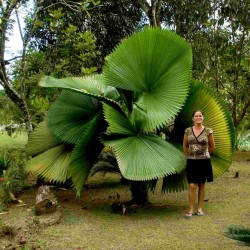
Ruffled fan Palm Seeds...
Pret
4,80 €
(SKU: PS 12)
Seeds Gallery EU,
5/
5
<meta http-equiv="Content-Type" content="text/html; charset=UTF-8" />
<h3><span style="font-size: 14pt;"><strong>Ruffled fan Palm Seeds (Licuala grandis)</strong> </span></h3>
<h3><span style="font-size: 14pt;"><strong><span style="color: #f00404;">Price for Package of 3 seeds.</span></strong></span></h3>
<p>Ruffled fan palm is perhaps one of the most interesting and elegant of all small palms. Its glossy, pleated, fan-like fronds are fantastic as are its drooping cluster of red fruits that mature late in the season. This evergreen, frost-tender palm is native to the wet, humid rainforests of the Republic of Vanuatu and the Solomon Islands east of Australia. It's a small understory palm that’s ideal for small, tropical landscapes as well as interiorscapes.</p>
<p><span>Atop the thin, fiber covered trunk of this palm is a crown of twelve to twenty beautiful leaves. Each glossy, deep green frond is wedge-shaped and looks as if it’s been pleated. The frond stems (petioles) are long and have sharp, curved teeth at the base. Most are held upright but the oldest arch gracefully. In early or midsummer, a cluster of yellowish white blossoms appear. These develop into small, round, red fruits by autumn.</span></p>
<p><span>Grow ruffled fan palm in partial shade or dappled sun when small and young. Older specimens will tolerate more sun if humidity is high and summer temperatures not too scorching. Although there are Licuala grandis known to have survived temperatures of -1.5° C. it is advisable to plant this palm in regions only where temperatures do not fall below 3 degrees C. For good health plant in a fast-draining soil that’s fertile and evenly moist. Sandy soil amended with lots of humus is ideal. For dramatic landscape effect, cluster ruffled fan palm beneath a tall shade tree or shaded building foundation. Indoors it will become a nice container specimen as long as it receives very bright light, warmth and its soil never becomes dry. This palm responds favorably to frequent, light fertilization.</span></p>
<p><span>Solitary trunk of up to 3 m in height and 5-6 cm in diam., Leaf circular, undivided and regularly pleated leaf; about 22 inch or more in diameter with a notched edge, with the old dry leaves persisting.</span> </p>
<p><a href="https://www.youtube.com/watch?v=Hx6WBaQ1h5M" target="_blank" class="btn btn-default" rel="noreferrer noopener">Ruffled fan Palm (Licuala grandis)</a></p>
<p><strong><span>Scientific name:</span></strong><span> Licuala grandis</span></p>
<p><strong><span>Common names</span></strong><span>: The Ruffled Fan Palm is also known Vanuatu Fan Palm, Palas Palm, and Ruffled Lantan Palm.</span></p>
<p><strong><span>Family:</span></strong><span> Arecaceae</span></p>
<p><strong><span>Origin:</span></strong><span> It is native to the Vanuatu Islands, off the coast of Australia.</span></p>
<p><strong><span>Appearance:</span></strong><span> It has a single slender trunk, 4-5 inches in diameter that takes years to develop. The Ruffled Fan Palm is known for its unique palmate, or fan-shape leaves, with attractive splitting patterns that make it stand out in any environment. Leaves are circular, luscious green, glossy, ruffled, hence the name Ruffled Fan Palm, about 22 inches in diameter, with notched tips.</span></p>
<p><strong><span>Flowers/Fruits:</span></strong><span> The inflorescence emerges from among the leaves bearing bisexual flowers, male and female reproductive organs grow on the same flower. Ruffled Fan Palm produces marble-like green fruit that turns red when ripe. This berry looking fruit is round with a single seed inside.</span></p>
<p><strong><span>Growth Rate:</span></strong><span> Slow. Licuala grandis is a very attractive, slow growing palm that can get up to 5-10ft tall, but usually doesn’t get higher than 6ft with a spread of 5-10ft wide.</span></p>
<p><strong><span>Outdoor/Indoor Use:</span></strong><span> Both.</span></p>
<p><strong><span>Cold Tolerance:</span></strong><span> It can tolerate cold down to 30F when mature enough. It is great for growing in USDA Zones 10a (30 to 35 F) to 11 (above 40 F).</span></p>
<p><strong><span>Light Req:</span></strong><span> Partial shade. It grows best in partial shade and should not be exposed to full sun.</span></p>
<p><strong><span>Water Req:</span></strong><span> High. It needs a lot of water with good drainage</span></p>
<p><strong><span>Maintenance:</span></strong><span> Easy. Make sure to protect it from high winds to avoid frond damage. To prevent nutritional deficiency, apply good quality palm fertilizer that has continuous release formula twice a year during growing season.</span></p>
<p><strong><span>Propagation:</span></strong><span> Propagated by seed. It might take as long as 12 months for seeds to sprout.</span></p>
PS 12 (3 S)


Planta rezistenta la frig si inghet
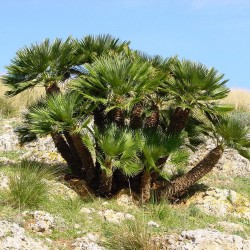
Mediterranean dwarf palm...
Pret
3,00 €
(SKU: PS 9)
Seeds Gallery EU,
5/
5
<h2><span style="font-size:14pt;"><strong>European fan palm, Mediterranean dwarf palm Seeds (Chamaerops humilis)</strong></span></h2>
<h2><span style="color:#ff0000;font-size:14pt;"><strong>Price for Package of 3 seeds.</strong></span></h2>
<p>Chamaerops is a genus of flowering plants in the palm family Arecaceae. The only currently fully accepted species is Chamaerops humilis, variously called European fan palm, or the Mediterranean dwarf palm. It is one of the more cold-hardy palms used in landscaping in temperate climates.</p>
<p>Chamaerops humilis is a shrub-like clumping palm, with several stems growing from a single base. It has an underground rhizome which produces shoots with palmate, sclerophyllous leaves.</p>
<p>The stems grow slowly and often tightly together, eventually reaching 2–5 m (10–20 ft) tall with a trunk diameter of 20–25 cm (8–10 in). It is a fan palm (Arecaceae tribe Corypheae), and as such, has leaves with petioles terminating in rounded fans of 10–20 leaflets. Each leaf is up to 1.5 m (5 ft) long, with leaflets 50–80 cm (20–30 in) long. The petioles are armed with numerous sharp, needle-like spines; these may protect the stem growing point from browsing animals.</p>
<p>The flowers are borne in dense, short inflorescences at the tops of the stems. The plants usually, but not invariably, are dioecious with male and female flowers on separate plants. The prophyll covers the flowers on the inflorescence until the sexual phase (anthesis) and then splits open apically into two triangular lobes. The number of flowers per inflorescence is highly variable for both male and female plants, depending on the size of the inflorescence. Female flowers are tri-ovulate.[6] Unripe fruits are bright green, turning to dull yellow to brown as they ripen during autumn (September–November). The seed (usually 0.6–0.8 g or 1⁄50–3⁄100 oz) contains a small cylindrical embryo, which is surrounded by several layers, from inner to outer as follows:</p>
<p>a nutritious endosperm,</p>
<p>a wide woody layer or endocarp,</p>
<p>a fleshy and fibrous mesocarp (the pulp), and</p>
<p>the thin outer layer or exocarp.</p>
<p><strong>Taxonomy</strong></p>
<p>Apart from the fully accepted Chamaerops humilis there currently are a few species of unresolved status plus tens of species synonymised with Chamaerops humilis.</p>
<p>The species Chamaerops humilis itself has three accepted varieties as follows:</p>
<p>Chamaerops humilis var. argentea André (syn. C. h. var. cerifera) – "Atlas mountain palm" of Northwest Africa. Leaves glaucous.</p>
<p>Chamaerops humilis var. epondraes – Northwest Africa. Leaves glaucous.</p>
<p>Chamaerops humilis var. humilis – Southwest Europe. Leaves green.</p>
<p>There also are at least three cultivars (C. humilis var. humilis 'Nana', C. humilis 'Vulcano', C. humilis 'Stella'). C. humilis 'Vulcano' is a compact, thornless cultivar. May be silvery, but less so than argentea. The leaves tend to be thicker, and the appearance of the plant is bushier than var. humilis or var. argentea.</p>
<p>The genus Chamaerops is closely related to the genus Trachycarpus. The genera differ in that Trachycarpus lacks the clumping habit only forms single stems without basal suckers), the spiny leaf stems (spineless in Trachycarpus), and in small details of the flower anatomy.</p>
<p><strong>Distribution</strong></p>
<p>Chamaerops humilis is one of only two palm species native to southern Europe, the other being Phoenix theophrasti. It is mainly found in southwestern Europe (Malta, Sicily, over all the Mediterranean coast of Spain and Portugal, central and southern Italy, some parts of the southern Mediterranean coast of France and Monaco, as well as northwest Africa (Morocco, Algeria, Tunisia). It is the northernmost naturally occurring palm in the world, with the northernmost standing at Hyères-les-Palmiers, at 43° 07′ N.</p>
<p><strong>Cultivation</strong></p>
<p>Chamaerops humilis is valued in gardening and landscaping in many parts of the world. It is very drought-tolerant once established.</p>
<p><strong>It is hardy to −12 °C (10 °F), but does prefer hot summers. </strong></p>
<p>It is a very slow-growing plant. The blue form of the species, native to high elevations of the Atlas Mountains, has recently been introduced into the trade and early reports indicate that it may be −12 °C (−22 °F) or more degrees hardier than the green form.</p>
<p>It has gained the Royal Horticultural Society's Award of Garden Merit.</p>
<p><strong>Ecology and interactions with animals</strong></p>
<p>Chamaerops humilis flowers in spring, typically from April to May. The plant also may be partly anemophilous, that is to say, wind-pollinated, but it is at least partly entomophilous, that is to say dependent on pollination by insects. Only one insect species is known to pollinate it, namely a specific weevil, Derelomus chamaeropsis in the family Curculionidae.[13] The nature of the relationship with the weevil is a version of nursery pollination mutualism with the weevil; the form this takes is that once pollinating weevils have found a satisfactory plant, whether male or female, they usually stay on the same plant until the end of its anthesis, finding shelter, egg-laying sites, and food in the inflorescences.</p>
<p>At anthesis, as is common in Angiosperms, both male and female Chamaerops humilis plants attract their pollinators with chemical compounds, but an unusual feature is that their scents are released by the leaves, and not by the flowers.[15] Towards the end of anthesis, weevils leave the plant and seek a new host plant, again either male or female.</p>
<p>Larval development of the weevil Derelomus chamaeropsis occurs within rachises of inflorescences of male plants during autumn and winter. At the beginning of the next flowering period, adult weevils emerge from the dry and brittle stems of old inflorescences of the previous year of male plants only. Those that hatch in female plants die without concluding their development. This is because the palmettos are adapted to prevent the pollinating weevils from destroying the female inflorescences with their burden of seed. Weevils have been shown to lay eggs within female inflorescences, but as soon as seeds start to develop, eggs or larvae fail to continue their life cycle. On the other hand, male inflorescences have completed their function after pollination, so it is advantageous to the plant's reproduction for the weevils to complete their life cycles and shelter in the male inflorescences, thereby remaining available for pollination when they emerge in the following season.</p>
<p>The ripe pulp of C. humilis has several important functions.</p>
<p>When ripened, the pulp smells strongly of rancid butter[18] and thus acts as a foraging cue for nocturnal frugivores that commonly are fundamentally carnivorous mammals such as badgers and foxes.</p>
<p>The pulp inhibits germination, ensuring that the seed does not germinate until has been dispersed.</p>
<p>The pulp also acts as a chemical or physical barrier against invertebrate seed predators, typically beetles, and in particular weevils.</p>
<p>Because of the combination of such functions in the pulp, the palm both benefits and suffers adverse consequences when carnivores feed on the fruit and thereby remove the pulp. On the one hand, the seeds that carnivores swallow, germinate more frequently than seeds in entire fruit. On the other hand, ingested seeds are more frequently destroyed by invertebrate pests than non-ingested seeds. However, because of the mobility of carnivores, their dispersal service is important to the palmetto, given the severe fragmentation and isolation of most populations across the increasingly densely populated Mediterranean basin.</p>
<p><strong>Uses and threats</strong></p>
<p>Chamaerops humilis has a wide distribution in uncultivated land, and it is adapted to regimes of frequent burning, which it survives largely by re-sprouting from underground rhizomes and from fire-damaged stems. Such factors make the species ecologically important in preventing erosion and desertification and in providing shelter and food to many species of animals.</p>
<p>Apart from its material benefits, this palmetto is of emotional value as a charismatic component of the "garrigues" and "macchias" of the Mediterranean coastline.</p>
<p>The leaves of the adult plants have been used to make brooms and for weaving mats, carrier baskets, and similar articles. For finer work the young, unopened leaves are treated with sulphur to soften them softer and provide supple fibre.</p>
<p>The husk, known in southern Spain as "higa", is edible before it becomes too tough to eat as it matures. Because of their bitterness and high tannin content, the fruit are not used for human food, but in traditional medicine they have been used as an astringent.[19]</p>
<p>Urbanization and other human activities are making such rapid inroads into the natural habitat of palmetto that they are raising concerns about its future and that of its environment. Accordingly there is an increase in regulations to protect both its stands and those of associated Mediterranean endemics.</p>
<p>Another conservation problem is that particularly in the northernmost parts of its natural range, Chamaerops humilis is seriously threatened by an introduced South American moth Paysandisia archon.[9][20] Also, this Mediterranean native palm is affected by the introduction of related ornamental species because of the concurrent introduction of seed predators (such as Coccotrypes dactyliperda and Dactylotrypes longicollis) that feed on both the introduced and native palms.</p>
PS 9 (3 S)

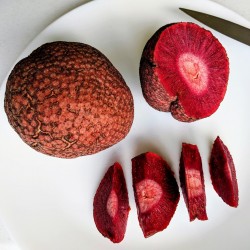
Seminte de piersici...
Pret
2,15 €
(SKU: V 108)
Seeds Gallery EU,
5/
5
<h2><strong>Seminte de piersici africane (Nauclea latifolia)</strong></h2>
<h2><span style="color: #ff0000;"><strong>Pret pentru pachet cu 10 seminte.</strong></span></h2>
<p>Nauclea este un gen de plante cu flori din familia Rubiaceae. Speciile sunt copaci sau arbuști veșnic verzi care sunt originari din Africa tropicală, unde crește la altitudini mai joase în pădurile din savană.</p>
<p>Un copac sau arbust de dimensiuni mici spre mijlocii, de până la 30 m înălțime, cu frunze mari, simple, vizibil nervurate și inflorescențe albe ciudate, dar frumoase, sferice, puternic parfumate. Produce fructe roșii, comestibile, cu pulpă suculentă, dulci, roșie, al căror gust amintește de mere.</p>
<p>În cultură, se adaptează bine la climatele tropicale și începe să producă fructe după doar câțiva ani. Până acum, însă, este în mare parte necunoscut în afara Africii.</p>
<p>Poate fi cultivat într-un ghiveci mare de flori.</p>
V 108 (10 S)





